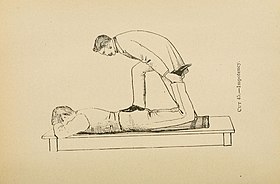
Back اعتلال العظام Arabic Osteopatía AST Osteopatia Catalan Osteopati Danish Osteopathie (Alternativmedizin) German Οστεοπαθητική Greek Osteopatio Esperanto Osteopatía Spanish Osteopatia Basque استخواندرمانی Persian
| Osteopathy | |
|---|---|
 OMT technique for the treatment of impotence in the 1898 Osteopathy Complete manual | |
| Alternative therapy | |
| MeSH | D026301 |
| ICD-10-PCS | 7 |
| ICD-9-CM | 93.6 |
| This article is part of a series on |
| Alternative medicine |
|---|
 |
| Osteopathic medicine in the United States |
|---|
| Andrew Taylor Still (founder) |
Osteopathy (from Ancient Greek ὀστέον (ostéon) 'bone', and πάθος (páthos) 'pain, suffering'), unlike Osteopathic medicine, is a pseudoscientific system of alternative medicine that emphasizes physical manipulation of the body's muscle tissue and bones.[1][2] In most countries, practitioners of osteopathy are not medically trained and are referred to as osteopaths.[3][4][5]
Osteopathic manipulation is the core set of techniques in osteopathy.[6] Parts of osteopathy, such as craniosacral therapy, have been described by Quackwatch as having no therapeutic value and have been labeled by them as pseudoscience and quackery.[7][8] The techniques are based on an ideology created by Andrew Taylor Still (1828–1917) which posits the existence of a "myofascial continuity"—a tissue layer that "links every part of the body with every other part". Osteopaths attempt to diagnose and treat what was originally called "the osteopathic lesion", but which is now named "somatic dysfunction",[6] by manipulating a person's bones and muscles. Osteopathic Manipulative Treatment (OMT) techniques are most commonly used to treat back pain and other musculoskeletal issues.[6][non-primary source needed][9]
Osteopathic manipulation is still included in the curricula of osteopathic physicians or Doctors of Osteopathic Medicine (DO) training in the US. The Doctor of Osteopathic Medicine degree, however, became a medical degree and is no longer a degree of non-medical osteopathy.
- ^ Snyder, John (2014). "Osteopathy in the NICU: False Claims and False Dichotomies". Retrieved 28 March 2017.
So other than a lower admissions standard and the focus on a pseudoscientific belief system, there is no difference between the two educational systems. So why should this two-tiered system even exist? It is time to rid ourselves of this pre-scientific, dual system of medical education.
- ^ "Osteopathic Manipulative Treatment". NYU Langone Medical Center. 23 July 2012. Archived from the original on 29 October 2014. Retrieved 5 September 2012.
- ^ "House of Delegates Resolution H-301 – RE: H229-A/05 Osteopath & Osteopathy – Use of the Terms". Archived from the original (PDF) on 20 March 2016. Retrieved 28 February 2011.
- ^ Crosby, J. (3 September 2010). "Promoting DOs: Words and medium change, but message stays the same". DO Magazine. Archived from the original on 12 October 2013.
- ^ "Style Guide for Reporting on Osteopathic Medicine". American Osteopathic Association. Archived from the original on 14 May 2013. Retrieved 17 December 2012.
- ^ a b c Howell, Joel D. (1999). "The Paradox of Osteopathy". New England Journal of Medicine. 341 (19): 1465–8. doi:10.1056/NEJM199911043411910. PMID 10547412.
- ^ "Dubious Aspects of Osteopathy". quackwatch.org. Retrieved 29 October 2016.
- ^ "Why Cranial Therapy Is Silly". quackwatch.com. 15 May 2004. Retrieved 29 October 2016.
- ^ Vincent C, Furnham A (1997). Manipulative Therapies: Osteopathy and Chiropractic. John Wiley & Sons. p. 15. ISBN 978-0-471-96645-6.
© MMXXIII Rich X Search. We shall prevail. All rights reserved. Rich X Search